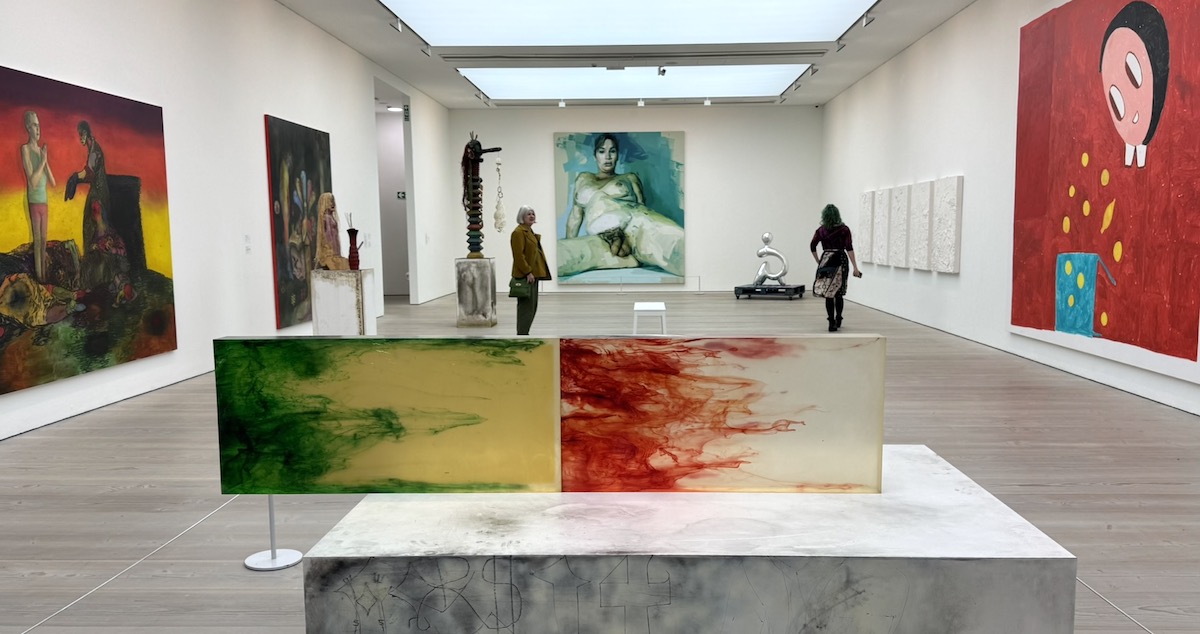There’s a certain irony in calling an exhibition The Long Now when its host, Saatchi Gallery, has built its reputation on immediacy — on the jolt of the new, the just-discovered, the shock that once sold tabloids and now fills Instagram reels. Yet here we are: forty years on, the institution that helped define the look and logic of contemporary British art is staging a self-reflective show, equal parts celebration and stocktake.
Curated by Philippa Adams, who knows the gallery’s inner workings better than anyone, The Long Now attempts to pin down the restless spirit that’s animated Saatchi since its 1985 debut. It spans two floors and nine galleries — a sprawling format that feels fitting for a place that has spent four decades cultivating scale and spectacle. The premise, loosely tied to the idea of long-term thinking, is elastic enough to contain both the explosive and the introspective. What it really offers is a mirror: how far contemporary art has travelled since Saatchi began collecting it, and how much of that journey the gallery itself helped to script.
The exhibition opens quietly, almost hesitantly, with a focus on gesture and material. Alice Anderson’s copper-thread forms sit beside the atmospheric surfaces of Rannva Kunoy and Carolina Mazzolari, each exploring what’s left of “mark-making” in an age of screens. It’s a soft entry, but not a sentimental one. There’s a physical urgency in these works that feels like resistance — the body insisting on its relevance.
Then comes the inevitable weight of the names: Tim Noble and Jake Chapman, Dan Colen, Polly Morgan, and André Butzer. Familiar provocateurs who once gave Saatchi its bite. Their inclusion reads less like nostalgia and more like an index of longevity — proof that the gallery’s alums, however polarising, remain central to the canon it helped define. Jenny Saville’s Passage anchors this section, a reminder of painting’s visceral pull. It’s as commanding as ever, unapologetically corporeal, and in this context, a statement of faith in the medium’s persistence.
Painting runs like a thread throughout. Works by Alex Katz, Michael Raedecker, and Martine Poppe extend the dialogue between surface and image that Saatchi’s programming has long cultivated. The mix of established and emerging voices feels purposeful — a reminder that this institution, for all its commercial infamy, has always been a testing ground for what comes next.
In the larger spaces, the tone shifts. Allan Kaprow’s YARD, a chaotic pile of tyres, invites movement and play. At the same time, Conrad Shawcross’s Golden Lotus (Inverted) — a vintage car reimagined as a spinning sculpture — hangs above like an emblem of creative recycling. Both works test the viewer’s role: are they a passive spectator or an active participant? Saatchi’s exhibitions have often blurred that line, sometimes crudely, sometimes cleverly. Here, it works.
Elsewhere, the show edges toward the future, or at least the uncertainty that comes with it. Chino Moya and Mat Collishaw explore the creeping omnipresence of technology — surveillance, automation, and the simulation of empathy. It’s a well-trodden theme, but handled with incredible precision that saves it from cliché. There’s also an environmental undercurrent that threads through Gavin Turk’s shattered Bardo and the industrial grandeur of Edward Burtynsky’s photography. The message isn’t subtle, but then subtlety has never been Saatchi’s language.
Light plays a meditative role in works by Olafur Eliasson, Chris Levine, and newcomer Frankie Boyle (not the comedian, but a deft experimenter with luminescent form). Their pieces act as pauses between heavier statements, giving the show a rhythm that alternates between density and air — not consistently smooth, but alive with contrast.
And then there’s 20:50. Richard Wilson’s lake of recycled engine oil returns, but this time it’s on the top floor, not in the bowels of the building. The location change alters everything. The reflection no longer reads as abyssal, but rather as aerial, like a mirage suspended in light. It’s still disorienting, still immaculate, and still capable of silencing a room. Few works could carry the weight of forty years with such deceptive calm. Warning, watch out, the oil is actually up to the level of the barrier, and you may find yourself dipping your hand in oil….
If The Long Now falters, it’s in its breadth. Too many works compete for attention; too many statements jostle for space. But perhaps that’s the point. The Saatchi Gallery has never been about coherence — it’s about accumulation, the restless layering of moments that eventually become history. This anniversary show doesn’t tidy that legacy; it embraces the sprawl.
At its best, The Long Now feels less like a retrospective and more like a pulse check — proof that the gallery, despite its age and the changing tides of the art world, still has one. It looks both backward and forward, and in doing so, lands squarely in the uneasy present.
Featured artists include: Alice Anderson, Olivia Bax, Frankie Boyle, Edward Burtynsky, Peter Buggenhout, André Butzer, Jake Chapman, Mat Collishaw, Dan Colen, John Currin, Jo Dennis, Zhivago Duncan, Olafur Eliasson, Rafael Gómezbarros, Ximena Garrido-Lecca, Damien Hirst, Tom Hunter, Henry Hudson, Alex Katz, Allan Kaprow, Maria Kreyn, Rannva Kunoy, Christopher Le Brun, Chris Levine, Ibrahim Mahama, Carolina Mazzolari, Jeff McMillan, Misha Milovanovich, Polly Morgan, Ryan Mosley, Chino Moya, Tim Noble, Alejandro Ospina, Steven Parrino, Martine Poppe, Michael Raedecker, Sterling Ruby, Jenny Saville, Conrad Shawcross, Soheila Sokhanvari, John Squire, Dima Srouji, Gavin Turk, Richard Wilson, Alexi Williams Wynn.
The Long Now runs from November 5, 2025, to March 1, 2026. Tickets £10.

